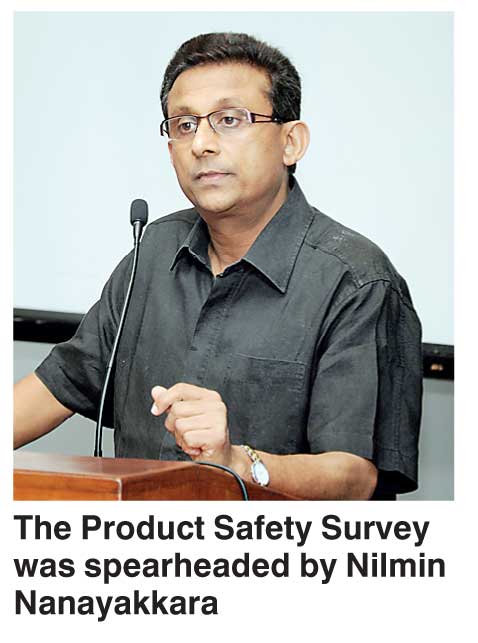Saturday Apr 27, 2024
Saturday Apr 27, 2024
Thursday, 29 December 2016 00:20 - - {{hitsCtrl.values.hits}}
 The Sri Lanka Association of Inbound Tour Operators (SLAITO) carried out an extensive Product Safety Survey to ensure the implementation and maintenance of appropriate safety management measures for tourists visiting Sri Lanka’s diverse tourist sites. This impactful initiative was spearheaded by SLAITO Past President Nilmin Nanayakkara, strongly supported by other SLAITO members. TUI Travel’s Head of Specialist and Activity Health and Safety Malcolm Ellis personally carried out the ‘Product Safety Survey’.
The Sri Lanka Association of Inbound Tour Operators (SLAITO) carried out an extensive Product Safety Survey to ensure the implementation and maintenance of appropriate safety management measures for tourists visiting Sri Lanka’s diverse tourist sites. This impactful initiative was spearheaded by SLAITO Past President Nilmin Nanayakkara, strongly supported by other SLAITO members. TUI Travel’s Head of Specialist and Activity Health and Safety Malcolm Ellis personally carried out the ‘Product Safety Survey’.
Commenting on the objective of the survey, Nilmin Nanayakkara said, “Sri Lanka tourism is on a rapid upward growth trajectory – and this realisation spurred us to commission an extensive health and safety audit of tourist sites to ensure that tourists are protected from potential accidents and hazards, so as to sustain the tourism industry into the future. I believe this survey and its subsequent recommendations, many of which were implemented, helped to establish and enforce minimum requirements to maintain a high standard of excellence in the services provided to tourists. This Product Safety Survey is aligned to SLAITO’s mandate to ‘promote and foster the rapid and long term growth of tourism by providing and maintaining a high standard of excellence’ to foster the long term growth of tourism.”
The survey covered key tourist sites in the country and assessed health and safety measures of current services at those sites, while ranking existing available safety measures in order of low, medium and high risk levels for tourists. In some of the top locations, gaps were identified. For example, although staff is present at the Dehiwela Zoo, barrier effectiveness to animal enclosures is low and many visitors bypass an outer rail/barrier and approach an inner cage, barrier or rail. The survey suggested that the zoo should specifically address this risk to separate visitors from the animals in residence.
A walking tour of Mihintale, taking in the Medamaluwa monastery, the rocky outcrop Aradhana Gala and the Mahaseya stupa uncovered several accident hazards. Warning of unprotected drops and caution to stay away from the edges of the stupa ‘platform’ needed to be prominently displayed as risk of slips and falls are high.
Tourists to Sigiriya were vulnerable to hornet or wasp attacks and adequate signage and measures also need to be put into place to ensure that in case of a wasp attack, adequate measures are in place to ensure minimum inconvenience or danger to tourists.
Other sites such as Pinnawela Elephant Orphanage posed a low risk to tourists as all safety measures are enforced at all times. However, World’s End posed a high risk to tourists due to unprotected drops and unexpected hazards from walking off trail.
At Yala and other national elephant parks in the country, the Survey found the need for all jeep safari operators to adopt the recommended minimum operating standards as detailed in the Jeep Safari Code of Practice. At Yala, animals known to be aggressive towards vehicles / people should be avoided – if spotted as part of a safari, and vehicles should be understanding instructions to not stop/move on. Vehicles entering the park should be checked against expected standards (as per Code of Practice) and those failing to meet standards should be advised of such and supplier details and deficiency details logged, and the driver/supplier informed that returning to the park on future occasions with same/similar failings will result in refusal of access and forfeit of entry fee. Park rules should be established which include only having clients exit vehicles and walk in the park under exceptional circumstances and even then, only under close care and supervision.
Overall it was found that at most sites, authorities and guides were not adequately communicating the dos and don’ts at each tourists site, which heightens awareness of risks amongst visitors and helps to avoid accidents.
Further, a survey of whale-watching at Mirissa revealed that there appeared to be a range of vessel sizes operating whale watching excursions. Given both the distance offshore the vessels achieve and the fact that some whales themselves can be of considerable size, it would seem prudent for the authorities to establish a minimum vessel size (length) as a requirement of any license to operate, as some vessel seemed inadequate in terms of size and condition.
Nilmin Nanayakkara explains that at the time of the survey, there were some attempts to effectively inform visitors of hazards and risks associated with particular sites and activities which were encouraging. However, the survey recommended further opportunities for enhancing safety related information and the development of a more consistent and comprehensive information giving strategy on a country-wide level. This timely and much-needed Product Safety Survey of Sri Lanka’s tourist sites paved the way for many safety measures to be implemented for a sustainable tourism product.